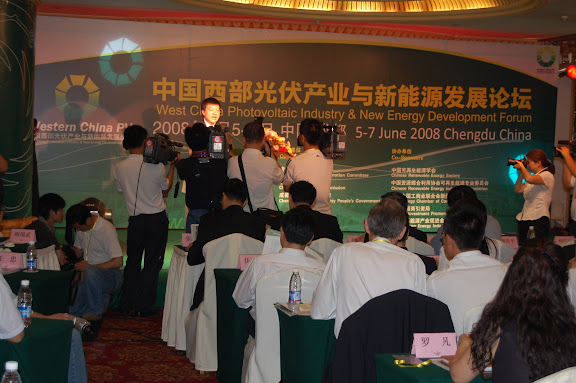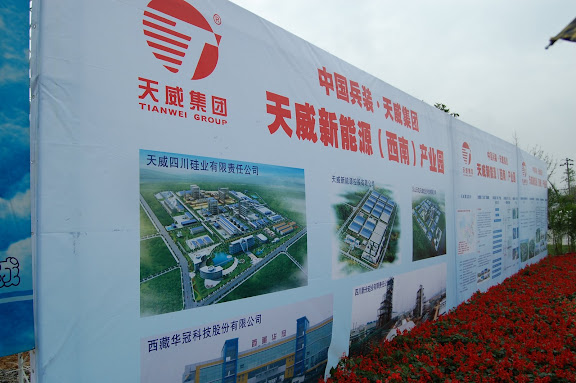 This post was originally published on The Green Leap Forward on Jun 17, 2008.
This post was originally published on The Green Leap Forward on Jun 17, 2008.
I attended the inaugural Western China Photovoltaic Industry & New Energy Development Forum which was held in the city of Chengdu, Sichuan province earlier this month (June 5-7).
A full transcript in Chinese of the proceedings is available here.
A recurring theme was the need to develop China’s domestic PV market. Although China is among the largest producers of solar photovoltaic (PV) cells in the world, over 90% of such PV cells are exported, leading Shi Dinghuan (石定寰), causing the Chairman of the Chinese Renewable Energy Industries Association (CREIA) to lament that China ships out its clean energy only to leave pollution (i.e. coal fired power generation) behind. At the end of last year, just 80 MW of solar PV was installed in China compared to almost 6,000 MW of wind energy. But more on this paradox later. Let's first see how Chengdu (成都)and Shuangliu (双流) in Sichuan province are seeking to leapfrog Jiangsu province and Baoding (in Hebei province) as the solar PV manufacturing hubs of China.

Sichuan: the Solar Gateway to the West
Sichuan is pushing solar as its next pillar industry. The governments of Chengdu and Shuangliu have established the Chengdu/Shuangliu Photovoltaic Industrial Park. The goal is to turn the region into a “Western Solar Valley” (“西部光谷”) and achieve RMB 100 billion in annual output. On the first day of the conference, some 17 agreements amounting to RMB 14.5 billion in investments into the Solar Valley were penned.
China has abundant solar resources, with solar irradiation comparable to areas of corresponding latitudes in the US, and comparing favorably over areas of corresponding latitudes in Japan and Europe (click here for Greenpeace’s China Solar PV Report 2007). Tibet, in particular, boasts the best solar irradiance of all of China, in part due to its elevated altitudes which greatly reduces irradiance diffusion. The development of a vibrant solar industry in the western regions is also consistent with the national “Go West” policy of developing China’s interior western and remote regions that have traditionally lagged behind the coastal economies. Incidentally, it is these very western remote regions that are homes to a significant portion of the estimated 15 million people in 2006 with no access to electricity. Distributed energy solutions such as solar PV, among others, can be the most cost-effective sources of power in these regions. But as alluded to earlier, these regions are not where the PV panels are being deployed.
In terms of solar PV manufacturing, Sichuan, and Chengdu/Shuagnliu in particular, boasts certain strategic advantages, such as favorable investment policies, an abundance of hydroelectric power and affordable electric power in general, and the availability of skilled labor from surrounding universities. It also a relatively well developed logistics supply chain given the pioneering work of the aviation industry which Chengdu/Shuangliu has up to now built its economic base around. But take a read at this post for a devil’s advocate point of view on shifting supply chains to the western regions.
Some anchor companies at the industrial park include Tianwei New Energy Resources and Apollo Solar, both of which are taking vertically integrated approaches in developing their operations in Sichuan. Tianwei New Energy Resources Southwest Industry Park, a subsidiary of Tianwei Group, will channel some RMB 3 billion into building solar production facilities with a capacity of producing 200 MW of silicon ingots, 50 MW of solar modules and 100 MW of solar cells and a solar research center.
Another recurring theme of the conference was thin-film PV technologies. The solar industry as a whole has hitherto been anchored on silicon based technologies. The recent explosion of solar demand, however, has cause a short to medium term bottle neck on silicon feedstock supplies, providing a boon to so-called “thin-film” technologies which use little to no silicon. Apollo Solar is striving to be the foremost vertically integrated thin-film PV module manufacturer. The competitive advantage of Apollo is that it has mining rights to certain quarries such as Dashuigou (大水沟) and Majiagou (马家沟) within Sichuan province that gives them access key precious metals such as telluride, bismuth, indium, selenium and others that go into making thin-film modules. Some conference attendees told me that the rumor on the market is that it is Apollo which is providing First Solar, the world’s biggest think-film manufacturer based in Arizona, U.S., with its supply of these precious metals. A factory visit to Apollo’s plant revealed metals processing infrastructure and a think film module manufacturing line in place, but nary an employee in sight. Reportedly, operations are to commence this October.
Quantity AND Quality
Anthony Chia, Vice President of Quality Control at Trina Solar based in Changzhou, Jiangsu province, said at the conference that the way to set Chinese module manufacturers apart from the competition is through quality. Until recently, Chinese modules have suffered from an image problem of having lower quality. Although that has quelled somewhat with established Chinese brands such as Trina and Suntech Power gaining increased global market shares, Chia envisions a world market where it is Chinese, rather European or North American institutions that set quality certification standards. In a very real sense, China’s PV module industry is vulnerable to the whims of these quality certification bodies (or if one might dare read into it, protectionist measures to protect local PV industries). For example in Europe, it currently takes three to six months for newly developed module to be approved for sale by one of these quality certification bodies in the European market, explained Chia. Even minor amendments to certification criteria may threaten to extend the approval process to up to a year. The essence of Chia’s message is this: If China is going to be the world’s leading producer of PV modules, does it not also make sense for it to be the standard setter for quality certification? (I suppose critics might gripe against a potential conflicts-of-interest.)
Domestic Solar Adoption: A Chicken and the Egg Problem?
But I come back to the key issue of developing China’s domestic solar market. There is no doubt that China will have continued success in producing homegrown companies that have mastered the process of low-cost manufacturing and dominate the global PV manufacturing market. But rather than exporting all this clean energy, the Chinese solar industry should think about how it can take steps to develop the local solar market as well.
In my few months of talking to industry professionals, I have gotten the overwhelming sense that everyone is waiting for the government to enact the right policies to spur development. In turn, I have also gotten the sense that the government is waiting for the cost of solar (which in the US costs about 20 to 30 cents per kwh compared to 5 cents for coal-fired power) to drop before it goes all out to push the solar power in the same way it is pushing wind. But the price of solar is not going to achieve these dramatic cost reductions without a scaling up of solar technology deployment, and what better market (for sheerly physical reasons) to scale up solar than in China?
Here’s a preliminary policy prescription from The Green Leap Forward:
- Enact feed-in-tariffs. The National Reform and Development Commission should promulgate comprehensive feed-in tariffs which require grid companies to purchase solar power at preferential tariff rates. These tariff premiums are to be fixed, but also gradually decreased over a period of, say, 20 years. As a possible "safety valve", these fixed tariff rates can be reexamined periodically to adjust for changing market conditions. The German government, for example, recently reevaluated the feed-in tariffs for solar. The premium that the grid company paid to solar power producers should be spread across all end-users, per the Renawable Energy Law of 2006. The hesitation of Chinese policy makers in adopting feed-in tariffs is something I hope to explore a little more in future posts.
- Strengthen Solar Lobby. Chinese solar companies should actively lobby the government to push ahead with solar policy reform. It is to their advantage, afterall, to develop a broader customer base. The newly established New Energy Chamber of Commerce may provide an avenue for such activities.
- Financial Innovation. Think about innovative ways of providing financing for solar installations. Given the early development of consumer credit in China, it may be some time before we can think of mass solar deployment in the residential sector, so continued advances along the credit front should be encouraged. For now, we should think about how third-party financing arrangements—whereby a facility engages another institution that installs and continues to own the solar panels, but sells the solar-generated electricity to the facility owner just like a utility, thereby relieving the user of prohibitive upfront costs of installing and owning the solar panels—can positively alter cost perceptions to solar power. Such third party financing institutions should target commercial and industrial entities, perhaps with the support of provincial and municipal governments which have energy efficiency and renewable energy goals to meet.
- Technical Capacity Building. Develop the necessary capacity and technical expertise for all steps of the PV value chain, but especially for downstream solar activities such as systems integration, installation, and after-sales services such as performance monitoring and system repairs and upgrades. This will require significant investments in education, but also lead to significant positive externalities such as job creation and spill-over benefits to other electrical engineering sectors.
- Government Procurement. Initiate mass procurement and deployment of PV in government facilities. Not only does the central government setting a right example work in China, but it provides a necessary starting point for the scaling up of PV deployment. The central government is large enough a bureaucracy after all.
- Strategically Increase R&D. Much hype is generated whenever announcements on breakthroughs in PV conversion efficiencies or silicon wafer thickness are achieved. But there are plenty of cost reductions to be gained in other parts of the solar value chain. Increasing efficiency of polysilicon production, module assembly, balance-of-systems or even installation are all avenues that R&D dollars can be channeled to increase technological (and hence cost) breakthroughs.
These merely represent my initial thoughts on how to push to PV adoption agenda in China. What are your thoughts? Please leave a comment!
Sidebar: This piece in Renewable Energy World on China's PV industry focuses on polysilicon production.




















